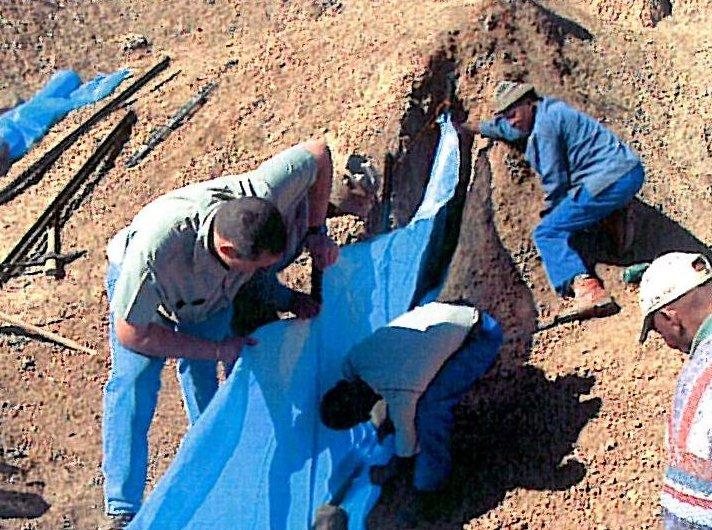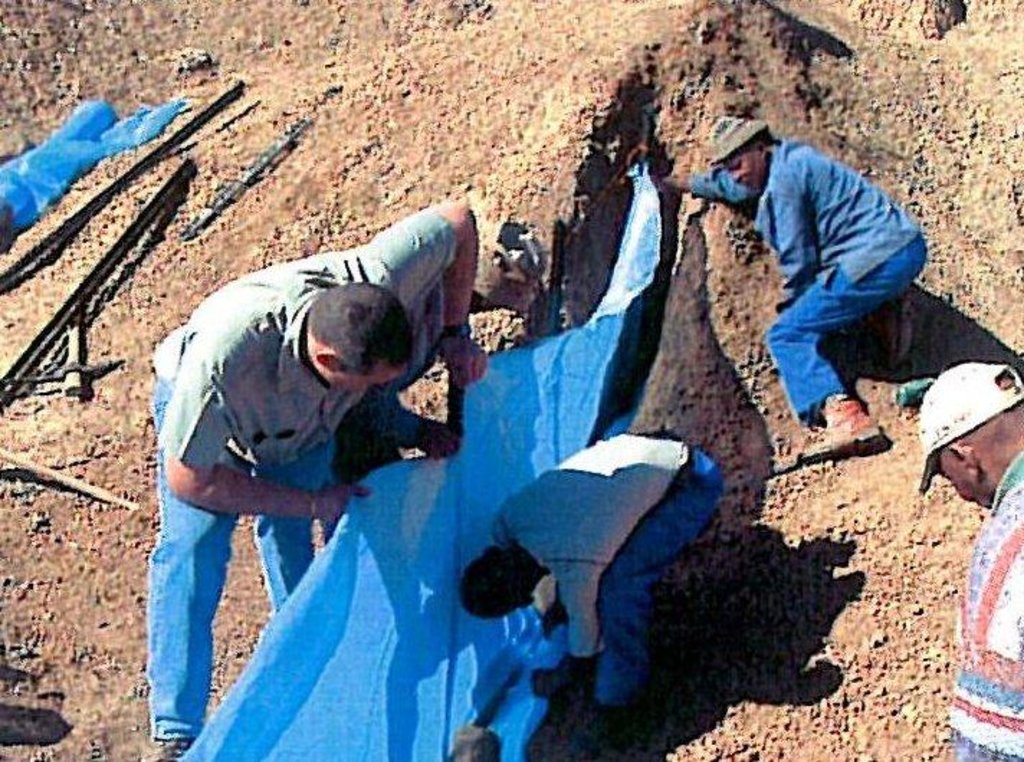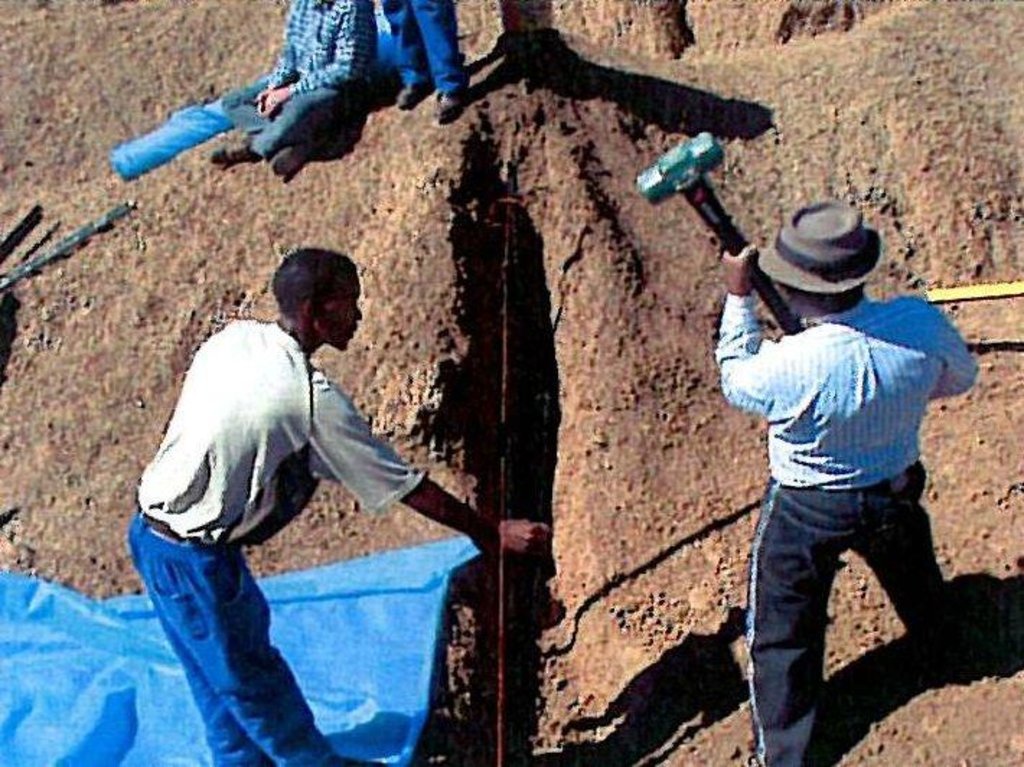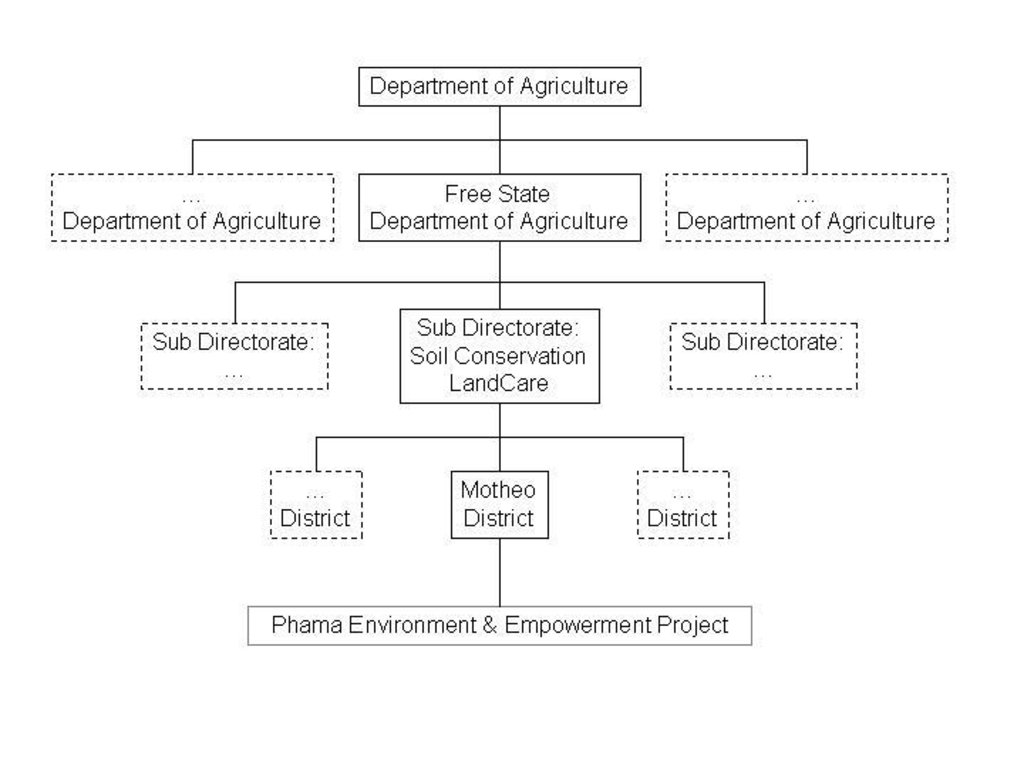Alternative and cost effective methods to control soil erosion [แอฟริกาใต้]
- ผู้สร้างสรรค์:
- การอัพเดท:
- ผู้รวบรวม: Christiann Smith
- ผู้เรียบเรียง: –
- ผู้ตรวจสอบ: Fabian Ottiger
approaches_2654 - แอฟริกาใต้
ดูส่วนย่อย
ขยายทั้งหมด ย่อทั้งหมด1. ข้อมูลทั่วไป
1.2 รายละเอียดที่ติดต่อได้ของผู้รวบรวมและองค์กรที่เกี่ยวข้องในการประเมินและการจัดเตรียมทำเอกสารของแนวทาง
1.3 เงื่อนไขที่เกี่ยวข้องกับการใช้ข้อมูลที่ได้บันทึกไว้ผ่านทาง WOCAT
ผู้รวบรวมและวิทยากรหลักยอมรับเงื่อนไขเกี่ยวกับการใช้ข้อมูลที่ถูกบันทึกผ่านทาง WOCAT:
ใช่
2. คำอธิบายของแนวทาง SLM
2.1 การอธิบายแบบสั้น ๆ ของแนวทาง
Alternative and cost effective methods to control soil erosion
2.2 การอธิบายอย่างละเอียดของแนวทาง
การอธิบายอย่างละเอียดของแนวทาง:
Aims / objectives: Research alternative, cost effective measures to control soil erosion Training of potentail contractor to errect soil conservation structures (Black Economic Empowerment) Wider acceptance and adoption of techniques by neighbouring communities
Methods: On-site research Literature research Needs analysis Trial and error Awareness ampaigns and information days Job creation to build structures
Stages of implementation: Control invader plants Literature research Design small structures Construction of erosion structures and stock watering Research on run-off trials Data analysis Information sharing
Role of stakeholders: Construction of small structures, controll invader plans, construction of stock watering
2.3 รูปภาพของแนวทาง
2.5 ประเทศ ภูมิภาค หรือสถานที่ตั้งที่ได้นำแนวทางไปใช้
ประเทศ:
แอฟริกาใต้
ภูมิภาค/รัฐ/จังหวัด: :
South Africa / Free State
ข้อมูลเฉพาะเพิ่มเติมของสถานที่ตั้ง:
Ladybrandt
2.6 วันที่เริ่มต้นและสิ้นสุดของแนวทาง
ระบุปีที่เริ่ม:
2006
การสิ้นสุดลง (ถ้าแนวทางไม่ได้ใช้อีกต่อไป):
2009
2.7 ประเภทของแนวทาง
- ใช้โครงงานหรือแผนงานเป็นฐาน
2.8 เป้าหมายหรือวัตถุประสงค์หลักของแนวทาง
The Approach focused mainly on SLM with other activities (Control invader and alien plants)
Research alternative, cost effective measures to control soil erosion Training of potentail contractor to errect soil conservation structures (Black Economic Empowerment) Wider acceptance and adoption of techniques by neighbouring communities
The SLM Approach addressed the following problems: Soil erosion Lost of grazing due to invader and alien plants Over grazing Lack of stock / grazing management Lack of knowledge
2.9 เงื่อนไขที่เอื้ออำนวยหรือเป็นอุปสรรคต่อการนำเทคโนโลยีภายใต้แนวทางนี้ไปปฏิบัติใช้
การมีไว้ให้หรือการเข้าถึงแหล่งการเงินและบริการ
- เป็นอุปสรรค
Community has limited financial resource for conservation
Treatment through the SLM Approach: Project will provide funding for implementation of structures
กรอบแนวทางในการดำเนินการด้านกฎหมาย (การถือครองที่ดิน สิทธิในการใช้ที่ดินและน้ำ)
- เป็นอุปสรรค
The existing land ownership, land use rights / water rights moderately hindered the approach implementation Stock owners association rules was too rigid and land users are not owners (communage) - no private ownership. Members of cattle association differ.
ความรู้เกี่ยวกับ SLM การเข้าถึงการสนับสนุนด้านเทคนิค
- เป็นอุปสรรค
Community does not have technical know-how to design small structures
Treatment through the SLM Approach: Project provides technical inpust
อื่นๆ
- เป็นอุปสรรค
Knowledge: Little knowledge about cost-effective measures to control soil erosion
Treatment through the SLM Approach: Project will provide funding for implementation of structures
3. การมีส่วนร่วมและบทบาทของผู้มีส่วนได้ส่วนเสียที่เกี่ยวข้อง
3.1 ผู้มีส่วนได้ส่วนเสียที่เกี่ยวข้องในแนวทางนี้และบทบาท
- ผู้ใช้ที่ดินระดับท้องถิ่นหรือชุมชนระดับท้องถิ่น
Stock owners, contractors and community members
Men will do more physical work like building rock structures or fitting of rock gabions
- ผู้เชี่ยวชาญ SLM หรือที่ปรึกษาการเกษตร
- รัฐบาลแห่งชาติ (ผู้วางแผน ผู้ทำการตัดสินใจ)
Provincial Department of Agriculture technical officials
- องค์การระหว่างประเทศ
3.2 การเกี่ยวข้องของผู้ใช้ที่ดินระดับท้องถิ่นหรือชุมชนระดับท้องถิ่นในช่วงต่างๆของแนวทาง
| ความเกี่ยวข้องของผู้ใช้ที่ดินระดับท้องถิ่นหรือชุมชนระดับท้องถิ่น | ระบุผู้ที่มีส่วนเกี่ยวข้องและอธิบายกิจกรรม | |
|---|---|---|
| การริเริ่มหรือการจูงใจ | ไม่ลงมือ | |
| การวางแผน | ไม่ลงมือ | |
| การดำเนินการ | จ่ายเงินหรือสนับสนุนจากภายนอก | |
| การติดตามตรวจสอบหรือการประเมินผล | ปฏิสัมพันธ์ | |
| Research | ไม่มี |
3.3 แผนผังแสดงขั้นตอนการทำงาน (ถ้ามี)
3.4 การตัดสินใจเลือกใช้เทคโนโลยี SLM
ระบุผู้ที่ทำการตัดสินใจเลือกเทคโนโลยีมากกว่าหนึ่งวิธีไปปฏิบัติใช้:
- ผู้เชี่ยวชาญ SLM เป็นผู้ตัดสินใจหลัก ที่ติดตามให้คำปรึกษากับผู้ใช้ที่ดิน
การอธิบาย:
Decisions on the method of implementing the SLM Technology were made by mainly by SLM specialists with consultation of land users
4. การสนับสนุนด้านเทคนิค การสร้างขีดความสามารถ และการจัดการด้านความรู้
4.1 การสร้างขีดความสามารถ / การอบรม
ได้มีการจัดอบรมให้แก่ผู้ใช้ที่ดินหรือผู้มีส่วนได้ส่วนเสียคนอื่น ๆ หรือไม่:
ใช่
- land user
รูปแบบการอบรม:
- ใช้พื้นที่ทำการสาธิต
- จัดการประชุมสู่สาธารณชน
- จัดคอร์ส
หัวข้อที่พูด:
Construction of SWC structures and training on veld management. Control of invader plants.
4.2 การบริการให้คำแนะนำ
ผู้ใช้ที่ดินมีการเข้าถึงการรับบริการให้คำปรึกษาหรือไม่:
ใช่
ระบุว่ามีบริการให้คำปรึกษาหรือไม่:
- ไปเยี่ยมชมสถานที่
การอธิบาย/แสดงความคิดเห็น:
Name of method used for advisory service: Cost effective erosion control and veld management; Key elements: Awareness, Meetings formal and informal, Farm visits and participatory approaches
Advisory service is quite adequate to ensure the continuation of land conservation activities; Empowered through project to continue with SWC activities
4.4 การติดตามตรวจสอบและประเมินผล
การติดตามตรวจสอบและประเมินผลเป็นส่วนหนึ่งของแนวทางหรือไม่:
ใช่
ความคิดเห็น:
technical aspects were regular monitored through measurements; indicators: Functionaing (effectiveness) of structures
socio-cultural aspects were ad hoc monitored through observations; indicators: Adoption of technology
area treated aspects were regular monitored through measurements; indicators: Area treatede / conserved
no. of land users involved aspects were regular monitored through measurements; indicators: No. of community actively involved
management of Approach aspects were regular monitored through measurements; indicators: Maintenance and acceptance
There were few changes in the Approach as a result of monitoring and evaluation: Redesign of small structures and different application of materials
4.5 การวิจัย
การวิจัยเป็นส่วนหนึ่งของแนวทางหรือไม่:
ใช่
ระบุหัวข้อเรื่อง:
- นิเวศวิทยา
ให้ข้อมูลเพิ่มเติมและให้ระบุผู้ทำการวิจัย:
Run-off trials and participatory approaches for community participation
Research was carried out on-farm
5. การสนับสนุนด้านการเงินและวัสดุอุปกรณ์
5.1 ระบุงบประมาณประจำปีสำหรับแนวทาง SLM นี้
ถ้าหากว่างบประมาณประจำปีไม่เป็นที่ทราบแน่นอน ให้ระบุช่วงลงไป:
- 10,000-100,000
แสดงความคิดเห็น (แหล่งของการระดมทุน ผู้บริจาคคนสำคัญ):
Approach costs were met by the following donors: government (Agricultural Research Council): 80.0%; national non-government: 15.0%; local community / land user(s): 5.0%
5.2 การสนับสนุนด้านการเงิน / วัสดุอุปกรณ์ให้แก่ผู้ใช้ที่ดิน
ผู้ใช้ที่ดินได้รับการสนับสนุนด้านการเงิน / วัสดุอุปกรณ์ไปปฏิบัติใช้เทคโนโลยีหรือไม่:
ใช่
5.3 เงินสนับสนุนสำหรับปัจจัยนำเข้า (รวมถึงแรงงาน)
- อุปกรณ์
| ระบุปัจจัยนำเข้าที่ได้รับการสนับสนุน | เห็นด้วยระดับไหน | ระบุเงินสนับสนุน |
|---|---|---|
| เครื่องจักร | ได้รับการช่วยเหลือทางการเงินบางส่วน | |
| เครื่องมือ | ได้รับการช่วยเหลือทางการเงินบางส่วน | |
- การเกษตร
| ระบุปัจจัยนำเข้าที่ได้รับการสนับสนุน | เห็นด้วยระดับไหน | ระบุเงินสนับสนุน |
|---|---|---|
| เมล็ด | ได้รับการช่วยเหลือทางการเงินแบบเต็ม | |
| ปุ๋ย | ได้รับการช่วยเหลือทางการเงินแบบเต็ม | |
| Biocides | ได้รับการช่วยเหลือทางการเงินแบบเต็ม | |
ถ้าแรงงานโดยผู้ใช้ที่ดินเป็นปัจจัยนำเข้าที่มีอยู่มากมาย ระบุด้วยว่าเนื่องจาก:
- จ่ายเป็นเงินสด
ความคิดเห็น:
Grant paid for labour
Material for SWC structures were fully financed
5.4 เครดิต
มีการจัดหาเครดิตมาให้ภายใต้แนวทาง SLM หรือไม่:
ไม่ใช่
6. การวิเคราะห์ผลกระทบและการสรุป
6.1 ผลกระทบของแนวทาง
ช่วยให้ผู้ใช้ที่ดินนำเอาเทคโนโลยี SLMไปใช้และบำรุงรักษาสภาพไว้ได้หรือไม่:
- ไม่ใช่
- ใช่ เล็กน้อย
- ใช่ ปานกลาง
- ใช่ อย่างมาก
Use of silt fences and soil boxes adapted by land users
ปรับปรุงประเด็นของการถือครองที่ดินหรือสิทธิในการใช้ ซึ่งขัดขวางการนำเทคโนโลยีไปใช้ให้ดีขึ้น:
- ไม่ใช่
- ใช่ เล็กน้อย
- ใช่ ปานกลาง
- ใช่ อย่างมาก
Improve general awareness and commitment of cattle owners The problem is unlikely to be overcome in the near future. Too many people - too much pressure on the land and unwillingness of local authorities to get involved.
Did other land users / projects adopt the Approach?
- ไม่ใช่
- ใช่ เล็กน้อย
- ใช่ ปานกลาง
- ใช่ อย่างมาก
Commercial farmers who visited project adopted and implemented some of the SWC methods deomnstrated / researched in projects.
6.4 จุดแข็งและข้อได้เปรียบของแนวทาง
| จุดแข็ง / ข้อได้เปรียบของแนวทางในทัศนคติของผู้ใช้ที่ดิน |
|---|
| Temporary job creation (How to sustain/ enhance this strength: Not sustainable if there are no follow up projects) |
| Improved natural resource condition (How to sustain/ enhance this strength: Maintain structures / control invasive plants / implement grazing system) |
| Contractor empowered with unique SWC methods - niche market (How to sustain/ enhance this strength: Continue empowerment with training and informatin sharing. He has to advertise his services.) |
| จุดแข็ง / ข้อได้เปรียบของแนวทางในทัศนคติของผู้รวบรวมหรือวิทยากรหลัก |
|---|
| Empowerment of community with knowledge and skills (How to sustain/ enhance this strength: Ensure the adaption and implementation of structures and maintenance of current structures) |
| Empowerment of contractor (How to sustain/ enhance this strength: Follow up projects and work for private sector) |
| Holistic approach towards environmental problems (How to sustain/ enhance this strength: systems approach deal with real causes of degradation. More partnerships and more stakholders involved.) |
| Cost effective methods to control soil conservation (How to sustain/ enhance this strength: More on-site research andawareness of test method technologies and approaches.) |
| Alien plant control (How to sustain/ enhance this strength: Follow up and more research monitoring and evaluation) |
| Improved veld management (How to sustain/ enhance this strength: Monitoring and evaluation) |
6.5 จุดอ่อน / ข้อเสียเปรียบของแนวทางและวิธีในการแก้ไข
| จุดอ่อน / ข้อเสียเปรียบในทัศนคติของผู้ใช้ที่ดิน | สามารถแก้ไขปัญหาได้อย่างไร |
|---|---|
| No ownership of land (land tennure - commonage) | Review use of commonages - need new policy |
| Low educational levels - difficalt to train, learn new technologies | Continue education, training and awareness |
| Contractor needs administrative empowerment | Capacity building |
| จุดอ่อน / ข้อเสียเปรียบในทัศนคติของผู้รวบรวมหรือวิทยากรหลัก | สามารถแก้ไขปัญหาได้อย่างไร |
|---|---|
| Lack of local expertise in SWC structures / small structures | Continue with researh and information shareing at national / international level. |
| Capacity on project management side | More and better trained project managers. |
| Financial support: Huge problem - small budget | Convince national donors about extent and degree of degradation problems. Look for private donors. |
| Politics exclude commercial farmers - project coud have bigger impact | Decision for restoration and conservation must be based on ecological needs and not political agendas. |
7. การอ้างอิงและการเชื่อมต่อ
7.1 วิธีการหรือแหล่งข้อมูล
- ไปเยี่ยมชมภาคสนาม การสำรวจพื้นที่ภาคสนาม
- การสัมภาษณ์กับผู้ใช้ที่ดิน
ลิงก์และโมดูล
ขยายทั้งหมด ย่อทั้งหมดลิงก์
ไม่มีลิงก์
โมดูล
ไม่มีโมดูล






